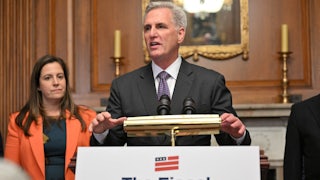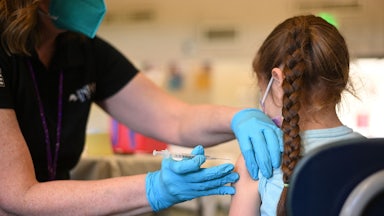In the middle of May, a number of House Democratic staffers and lawmakers were irate. The House Appropriations Committee had begun rolling out its list of bills as part of the annual Fiscal Year 2024 Community Project Funding. These Democrats were furious because projects in Republican districts were, almost to a T, getting more funding than Democratic ones. That was despite the fact that of the 535 earmark projects across three categories, there were 23 more proposals in Democratic districts than in Republican ones.
The difference in spending was even more jarring. In total, an analysis by The New Republic found, House Republicans were set to receive nearly three times what Democrats were getting in allocations for earmarks, the pork-barrel requests members make for federal spending on projects in their districts. Democrats requested 279 projects and were given a total of $246 million for them. Republicans, on the other hand, sought fewer projects—256—but were given a whopping $706.43 million for theirs.
“We are fuming,” a Democratic Hill staffer texted me alongside an angry emoji. “This is pretty insane.… Like some [Republicans] are getting [$]10 million earmarks in this bill and we are all capped at [$1] mil.”
In a Dear Colleague letter sent out to the minority members on the House Appropriations Committee, ranking member Rosa DeLauro wrote that “the majority is allocating resources to the minority while refusing to acknowledge that we have more members participating and more projects requested.”
Earmark funding levels are determined by House leadership in consultation with the Appropriations Committee. Some of this is to be expected, since Republicans are in the majority, albeit a slim one, in the House of Representatives.
But the imbalance is nonetheless stark. For instance, a fire station construction project in Bridgeport, Ohio, which is in Republican Congressman Bill Johnson’s district, got $2.25 million. But construction for a fire station in Southbridge, Massachusetts, which is in Democratic Congressman Richard Neal’s district, got $1 million. Or in the Waynesburg, Pennsylvania, district represented by Republican Congressman Guy Reschenthaler, a library improvements project got $5 million. Meanwhile, a library renovation and expansion plan in Whitefield, New Hampshire, which is represented by Democrat Annie Kuster, was granted only $1 million.
Our analysis found that the average amount of money a Republican district got for an “Agriculture, Rural Development, Food and Drug Administration, and Related Agencies”–type project was $1.68 million. But the average amount of money a project in the same category in a Democratic district got was $772,303.
In the set of earmarks for the Homeland Security appropriation bill, Republican Congressman Trent Kelly of Mississippi got $3 million for a DeSoto County Operations Center project, while Democratic Congressman Andy Kim of New Jersey got only $637,195 for a similar project in his district. In Michigan, an earmark to replace lead service lines in St. Charles, Michigan, represented by Democratic Congressman Dan Kildee, got $1 million, but a water infrastructure improvements project in Indiantown, Florida, in Republican Congressman Brian Mast’s district, got $3 million.
There are exceptions to this pattern. Some Democratic projects did get more money than Republican ones. And for the earmarks in the Military Construction, Veterans Affairs, and Related Agencies bill, some Democratic projects were funded substantially. But the devil is in the details there too. While the average amount of money allotted to Democrats in this category was $5 million, more than the $1.3 million for Republicans, the number of projects for Republicans was seven times greater than for Democrats. And overall, the total spending on projects in Republican districts was $279,275,000 while the total amount in Democratic districts was just $15,283,000.
A spokesperson for the GOP majority on the Appropriations Committee did not respond to two emails.
The analysis was done by taking the allotted amounts included in the 2024 Community Project Funding programs for fiscal year 2024. As of this writing, three categories for the F.Y. 2024 CPF have been announced: Agriculture, Rural Development, Food and Drug Administration, and Related Agencies; Homeland Security; and Military Construction, Veterans Affairs and Related Agencies. The figures were then put in an Excel spreadsheet and sorted into projects by party affiliation. Any member of Congress who requested an earmark project and was listed in these public filings was included in this analysis. There are earmarks that, as of this writing, are yet to be announced in the remaining bill categories like Energy and Water, Interior and Environment, Transportation-HUD, and Commerce-Justice-Science.
Some of this is to be expected. Some of this is the spoils of victory. That said, it’s pretty clear that the way the process works in the House benefits whichever party is in the majority—and its constituents.
“It’s more lopsided than I would expect,” said Zach Moller, economic program director at Third Way, a centrist Democratic think tank. “I mean it’s about 25 percent Democrat, three-quarters Republican. If we were to look at how Congress divides the spending between the majority and minority for committees, it’s two-thirds for the majority, one-third for the minority. So it’s lopsided in that respect. And given that the majority for the House Republicans is four votes, it’s particularly lopsided.”
In 2021 then–House Appropriations Committee Chair DeLauro unveiled a much-anticipated plan to bring back earmarks. A big part of the plan was substantial changes to the process as a means to foster bipartisanship. The plan capped earmark spending at 1 percent of discretionary spending, lawmakers could submit a maximum of 10 project requests, and the requests would have to be posted online. Lawmakers had to detail their requests. There would also be a regular audit by a federal watchdog of, in the words of Politico, “a sampling of earmarks.”
Earmarks were renamed Community Project Funding. Earmarks’ resurrection sparked an effective congressional gold rush as lawmakers rushed to get funds. Over 300 lawmakers looked to nab $21 billion in funding for specific projects according to The Washington Post.
That was noteworthy, especially as it pertained to Republicans, because in recent years earmarks have become political anathema for the party. In a 2022 op-ed for The Washington Times, Representative Tom McClintock wrote, “Some say that earmarks simply assure that local governments get a fair break, particularly for the minority. No. What they actually do is turn the federal budget into a grab-bag for local pork spending by the most powerful members in the House.” Back in 2010, GOP Representative Ken Calvert hailed House Republicans’ move to end the practice of earmarks by saying, “House Republicans are ready to lead the fight for lower spending, more transparency and responsibility in Washington.”
But with earmarks back in Congress, Republicans have been all too eager to secure plenty of pork for their constituents. A tally by Roll Call in April found that “33 of the 40 freshman House Republicans,” as well as some of the most conservative lawmakers in federal politics, like Georgia’s Marjorie Taylor Greene and Maryland’s Andy Harris, grabbed for the pork.
This latest tally shows that “principled” opposition to earmarks is dead now. The fact that the process is stacked in Republicans’ favor isn’t apparent to everyone on Capitol Hill. Reacting to the results of the analysis, one Democratic staffer told me, “If we didn’t do what they’re doing now, we’re idiots.” In fact Democrats didn’t quite do what Republicans were doing now. In the omnibus appropriations bill—the final appropriations bill where Democrats were fully in control—Democrats had 54 percent of total earmark dollars (a few projects were requested by both Democrats and Republicans). By comparison, in these three bills, House Republicans are getting 74 percent.






